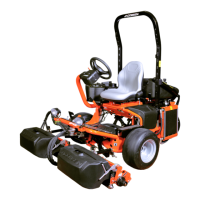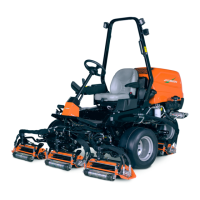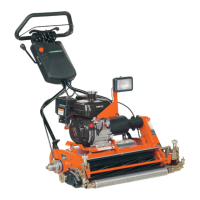HYDRAULICS
8M-59
Charge Relief Valve
1. Drain the hydraulic fluid from the tank.
2. Remove the charge relief valve plug, spring, and
cone (Figure 8M-4).
3. Inspect for debris and damage. Clean or replace
as necessary.
4. If the relief valve is not sticking or damaged, install
shims to increase pressure or remove shims to
decrease pressure.
5. If the charge pump pressure cannot be adjusted:
a. The charge pump is faulty.
b. The traction circuit has excessive internal leak-
age.
Figure 8M-4. Relief Valve
Implement Relief Valve Pressure Test for
Steering and Lift
1. Shut off the engine.
2. Install a 2000 psi (138 Bar) pressure gauge and
in-line tee fitting in the charge pump pressure port
on the traction pump (Figure 8M-5).
Figure 8M-5. Pressure Gauge Connection
3. Set the parking brake, start the engine, and
advance the engine speed to the full throttle
position.
4. Raise the deck and hold the lift lever in the raised
position; record pressure reading.
5. Turn the steering wheel against the steering stop
and record pressure reading.
6. Pressures should match in steps 4 and 5.
7. The implement relief valve pressure should be
900 to 1000 psi (62 to 69 Bar).
8. Reduce engine speed to 1750 rpm and repeat
steps 4 and 5. Pressure should still be within
range.
Conclusion
• If the implement relief valve pressure is within range
at both high and low engine rpm settings, the
implement relief and charge pump are okay.
NOTICE
The implement relief valve controls the maximum
pressure for steering and lift circuits. This test should
be carried out before testing steering and lift circuits.
Traction
Pump
Charge Pressure
Relief Valve
Tee
Fitting
0 to 2000 psi
(0 to 13790 kPa)
Gauge
Charge Pump Pressure Port

